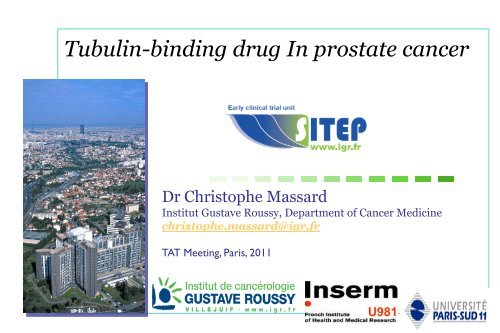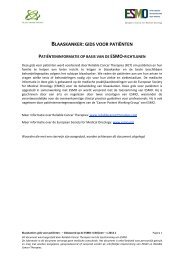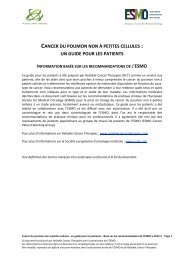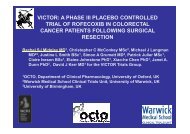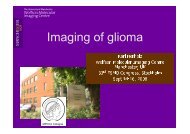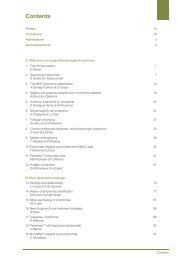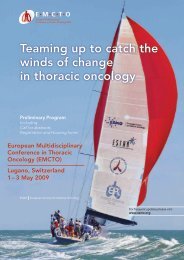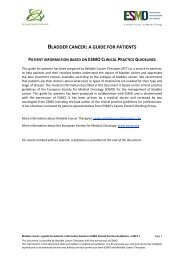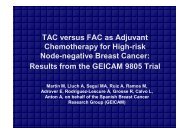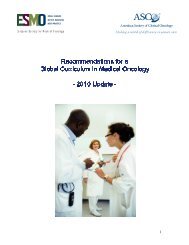TAT 2011 presentation: Tubulin-binding drugs in prostate cancer
TAT 2011 presentation: Tubulin-binding drugs in prostate cancer
TAT 2011 presentation: Tubulin-binding drugs in prostate cancer
Create successful ePaper yourself
Turn your PDF publications into a flip-book with our unique Google optimized e-Paper software.
<strong>Tubul<strong>in</strong></strong>-<strong>b<strong>in</strong>d<strong>in</strong>g</strong> drug In <strong>prostate</strong> <strong>cancer</strong><br />
Dr Christophe Massard<br />
Institut Gustave Roussy, Department of Cancer Medic<strong>in</strong>e<br />
christophe.massard@igr.fr<br />
<strong>TAT</strong> Meet<strong>in</strong>g, Paris, <strong>2011</strong><br />
U981
Chemotherapy <strong>in</strong> Prostate Cancer before 2010…<br />
Cl<strong>in</strong>ical progression of Prostate Cancer<br />
Androgen deprivation<br />
(Hugg<strong>in</strong>s, 1941)<br />
Androgen deprivation<br />
Docetaxel based chemotherapy<br />
(Tannock; Petrylack 2004)
Docetaxel based chemotherapy <strong>in</strong> CRPC<br />
New tubul<strong>in</strong> agent <strong>in</strong> CRPC: Cabazitaxel<br />
Other <strong>drugs</strong> and Comb<strong>in</strong>ation therapy<br />
Strategy <strong>in</strong> <strong>prostate</strong> <strong>cancer</strong> (early stage)<br />
Perspectives
R<br />
N=1006<br />
TAX 327<br />
Mitoxantrone 12 mg/m 2 q 21 days<br />
Prednisone 5 mg po bid<br />
Docetaxel 75 mg/m 2 q 21 days<br />
Prednisone 5 mg po bid<br />
Dexamethasone 8 mg 12, 3 and 1 hour<br />
prior to D<br />
Docetaxel 30 mg/m 2 /wk 5 of 6 wks<br />
Prednisone 5 mg po bid<br />
Dexamethasone 8 mg 1 hour prior to D<br />
Tannock IF, et al: NEJM 351:1502-12, 2004<br />
Docetaxel based chemotherapy <strong>in</strong> CRPC:<br />
TAX 327 and SWOG 9916<br />
R<br />
N=770<br />
SWOG 9916<br />
Mitoxantrone 12 mg/m 2 q 21 days<br />
Prednisone 5 mg po bid<br />
Docetaxel 60 mg/m 2 IV J2/3 weeks<br />
Dexamethasone 20 mg x3/d<br />
Petrylak DP, et al: NEJM 351:1513-20, 2004
TAX 327<br />
Median OS: 18.9 months vs. 16.5 months<br />
HR: 0.76 (0.62-0.94)<br />
Tannock IF, et al: NEJM 351:1502-12, 2004<br />
Docetaxel based chemotherapy <strong>in</strong> CRPC:<br />
Overall Survival<br />
SWOG 9916<br />
Median OS: 17.5 months vs. 15.6 months<br />
HR: 0.80 (0.67-0.97)<br />
Petrylak DP, et al: NEJM 351:1513-20, 2004
Chemotherapy works!<br />
Aris<strong>in</strong>g questions<br />
What to do when docetaxel eventually fails?<br />
Docetaxel alone or <strong>in</strong> comb<strong>in</strong>ation (estramust<strong>in</strong>e)?<br />
Early (asymptomatic) or late (symptomatic) chemotherapy?
Docetaxel based chemotherapy <strong>in</strong> CRPC<br />
New tubul<strong>in</strong> agent <strong>in</strong> CRPC: Cabazitaxel<br />
Other <strong>drugs</strong> and Comb<strong>in</strong>ation therapy<br />
Strategy <strong>in</strong> <strong>prostate</strong> <strong>cancer</strong> (early stage)<br />
Perspectives
Mitoxantrone after first l<strong>in</strong>e Docetaxel<br />
Author Response rate<br />
Michels (n=35) 15%<br />
Oh (n=35) 6%<br />
(PFS: 6 weeks)
New semi-synthetic taxane<br />
Cabazitaxel: A Next-Generation Taxane<br />
Selected to overcome the<br />
emergence of taxane resistance<br />
(poor aff<strong>in</strong>ity for drug efflux pomp)<br />
Microtubule stabilizer<br />
Precl<strong>in</strong>ical data<br />
As potent as docetaxel aga<strong>in</strong>st<br />
sensitive cell l<strong>in</strong>es and tumor<br />
models<br />
Activity aga<strong>in</strong>st tumor cells and<br />
tumor models that are resistant<br />
to taxanes<br />
Cl<strong>in</strong>ical data<br />
DLT was neutropenia<br />
Antitumor activity <strong>in</strong><br />
taxane resistant CRPC<br />
No phase II data <strong>in</strong> CRPC<br />
9
Cabazitaxel + prednisone (CBZP) versus mitoxantrone<br />
+ prednisone (MP) <strong>in</strong> the treatment of metastatic castration-resistant <strong>prostate</strong> <strong>cancer</strong><br />
(mCRPC)<br />
previously treated with a docetaxel-based regimen<br />
F<strong>in</strong>al Results of the Phase III TROPIC Trial<br />
Oliver Sartor, MD<br />
Piltz Professor of Cancer Research<br />
Tulane University School of Medic<strong>in</strong>e<br />
New Orleans, USA<br />
Johann de Bono, MD, PhD<br />
Reader <strong>in</strong> Experimental Cancer Medic<strong>in</strong>e<br />
The Institute of Cancer Research<br />
The Royal Marsden Hospital<br />
Surrey, UK<br />
On behalf of the TROPIC Investigators<br />
1
cabazitaxel 25 mg/m² q 3 wk<br />
+ prednisone* for 10 cycles<br />
(n=378)<br />
*Oral prednisone/prednisolone: 10 mg daily.<br />
Primary endpo<strong>in</strong>t: OS<br />
Secondary endpo<strong>in</strong>ts: Progression-free<br />
survival (PFS), response rate, and safety<br />
TROPIC: Phase III Registration Study<br />
146 Sites <strong>in</strong> 26 Countries<br />
mCRPC patients who progressed dur<strong>in</strong>g and after<br />
treatment with a docetaxel-based regimen<br />
(N=755)<br />
Stratification factors<br />
ECOG PS (0, 1 vs. 2) • Measurable vs. non-measurable disease<br />
mitoxantrone 12 mg/m² q 3 wk<br />
+ prednisone* for 10 cycles<br />
(n=377)<br />
Inclusion: Patients with measurable disease must have<br />
progressed by RECIST; otherwise must have had new<br />
lesions or PSA progression
Patients characteristics
Most Frequent Grade ≥3 Treatment-Emergent AEs*<br />
Safety Population<br />
1<br />
3
Deaths <strong>in</strong> patients who received at least one dose of study treatment
Overall Survival and Progression Free Survival (TROPIC trial)<br />
Median OS: 15.1 months (CBZ) vs. 12.7 monthsb (M)<br />
HR: 0.70 (0.59-0.83)<br />
Median PFS: 2.8months (CBZ) vs. 1.4 monthsb (M)<br />
HR: 0.74 (0.64-0.86)<br />
De Bono et al, Lancet 2010
Overall Survival <strong>in</strong> subgroups of patients (TROPIC trial)
Chemotherapy works <strong>in</strong> second l<strong>in</strong>e!<br />
What to do when docetaxel eventually fails?<br />
Cabazitaxel or Abiraterone or …cl<strong>in</strong>ical trials<br />
Docetaxel alone or <strong>in</strong> comb<strong>in</strong>ation (estramust<strong>in</strong>e)?<br />
Early (asymptomatic) or late (symptomatic) chemotherapy?
Docetaxel based chemotherapy <strong>in</strong> CRPC<br />
New tubul<strong>in</strong> agent <strong>in</strong> CRPC: Cabazitaxel<br />
Other <strong>drugs</strong> and Comb<strong>in</strong>ation therapy<br />
Strategy <strong>in</strong> <strong>prostate</strong> <strong>cancer</strong> (early stage)<br />
Perspectives
Ixabepilone+/-<br />
EMP<br />
Epothilones and <strong>prostate</strong> <strong>cancer</strong><br />
New class of cytotoxic tubul<strong>in</strong> agents<br />
(Sorangium cellulosum)<br />
Large ant<strong>in</strong>eoplastic activity<br />
In particular <strong>in</strong> taxane-resistant models<br />
(breast, <strong>prostate</strong> <strong>cancer</strong>)<br />
Pts (n) Decl<strong>in</strong>e PSA RR mOS<br />
(months)<br />
92 48-69% 32-48% NA<br />
Patupilone 45 13% (3/6 previous<br />
taxane)<br />
0% 13.4<br />
Galsky et al, 2005<br />
Hussa<strong>in</strong> et al, 2009
New <strong>drugs</strong> <strong>in</strong> CaP<br />
(w/wt Docetaxel)<br />
Target<strong>in</strong>g bone<br />
Target<strong>in</strong>g angiogenesis<br />
Target<strong>in</strong>g IL6<br />
Target<strong>in</strong>g AR<br />
Vitam<strong>in</strong> D analog<br />
Target<strong>in</strong>g IGF-R<br />
Endothel<strong>in</strong>-1<br />
Rx-pharms<br />
Rank-L axis<br />
- ZD 4054, Atrasentan<br />
- Samarium<br />
- Denosumab<br />
- Bevacizumab<br />
-VEGF-Trap<br />
- ZD 64 74<br />
Centocor<br />
Abiraterone, MDV3100, TAK700…<br />
DN-101 (calcitriol)<br />
Anti-IGF-R<br />
Chemotherapy Estramust<strong>in</strong>e, Satraplat<strong>in</strong><br />
Vacc<strong>in</strong>es APC 8015 (Provenge)<br />
GVAX
Estramust<strong>in</strong>e: Nornitrogen mustard-estradiol conjugate
Overall survival: chemotherapy + estramust<strong>in</strong>e<br />
No. Events / No. Entered<br />
Study Estramust<strong>in</strong>e Control<br />
(a) Taxanes and epothilone<br />
MSKCC 24/47 26/48 -2.0 12.4<br />
USON 70/81 80/85 -11.5 36.1<br />
Aventis 31/48 31/44 -1.9 15.3<br />
Subtotal (a) 125/176 137/177 -15.4 63.8 21% 11<br />
(b) V<strong>in</strong>blast<strong>in</strong>e<br />
Trend test for PS<br />
versus chemotherapy alone<br />
O-E Variance<br />
MDA 28/29 30/30 1.6 13.2<br />
Hoosier 94/94 98/98 -11.5 46.5<br />
Subtotal (b) 122/123 128/128 -9.9 59.7 15% 12<br />
Total (a ... b) 247/299 265/305 -25.3 123.5<br />
Test for heterogeneity:<br />
Test for <strong>in</strong>teraction:<br />
2<br />
4<br />
2<br />
1<br />
= 2.07 p = 0.72<br />
= 0.17 p = 0.68<br />
Hazard ratio Risk Redn<br />
(Estramust<strong>in</strong>e / Control) ( SD)<br />
19% 8<br />
0.0 0.5 1.0 1.5 2.0<br />
Estramust<strong>in</strong>e better | Control better<br />
Estramust<strong>in</strong>e effect with p = 0.02<br />
MECaP<br />
Meta-analysis of Estramust<strong>in</strong>e<br />
EstrEstrEstramust<strong>in</strong>eAmifost<strong>in</strong>e<br />
<strong>in</strong> Prostate Cancer<br />
ost<strong>in</strong>eChemotherapy
OS<br />
Patients at risk<br />
Survival<br />
1.0<br />
0.8<br />
0.6<br />
0.4<br />
0.2<br />
0.0<br />
Chemotherapy + Estramust<strong>in</strong>e<br />
vs Chemotherapy alone<br />
0.0 0.5 1.0 1.5 2.0<br />
Time (Years)<br />
Control 304 235 153 101 46<br />
Estramust<strong>in</strong>e 299 255 180 107 62<br />
MECaP<br />
Meta-analysis of Estramust<strong>in</strong>e<br />
EstrEstrEstramust<strong>in</strong>eAmifost<strong>in</strong>e<br />
<strong>in</strong> Prostate Cancer<br />
ost<strong>in</strong>eChemotherapy<br />
HR= 19%, p= 0.02<br />
Fizazi et al., Lancet Oncol 2007
Bone metastases<br />
from <strong>prostate</strong> <strong>cancer</strong>
New <strong>drugs</strong> <strong>in</strong> CaP<br />
(w/wt Docetaxel)<br />
Target<strong>in</strong>g bone<br />
Target<strong>in</strong>g angiogenesis<br />
Target<strong>in</strong>g IL6<br />
Target<strong>in</strong>g AR<br />
Vitam<strong>in</strong> D analog<br />
Target<strong>in</strong>g IGF-R<br />
Endothel<strong>in</strong>-1<br />
Rx-pharms<br />
Rank-L axis<br />
- ZD 4054, Atrasentan<br />
- Samarium, Strontium…<br />
- Denosumab<br />
- Bevacizumab<br />
-VEGF-Trap<br />
- ZD 64 74<br />
Centocor<br />
Abiraterone, MDV3100, TAK700…<br />
DN-101 (calcitriol)<br />
Anti-IGF-R<br />
Chemotherapy Estramust<strong>in</strong>e, Satraplat<strong>in</strong><br />
Vacc<strong>in</strong>es APC 8015 (Provenge)<br />
GVAX
CRPC and bone metastases<br />
Induction regimen: n=43<br />
- docetaxel 70 mg/m 2 day 2<br />
- estramust<strong>in</strong>e 10 mg/Kg/day, day 1-5<br />
(1 cycle every 3 weeks)<br />
Response (n=31) or<br />
stabilization (n=11)<br />
Progression<br />
n=1<br />
Consolidation regimen: n=42<br />
- docetaxel 20 mg/m 2 /w x 6 w<br />
- samarium 1 <strong>in</strong>jection week 1 (37 MBq/Kg)<br />
Median: 29 months (20 – 34)<br />
1-year survival rate: 76% (62%-87%)<br />
2-year survival rate: 63% (47%-77%)
Secretory cluster<strong>in</strong><br />
is a stress activated<br />
cytoprotective chaperone
40 pts enrolled with<br />
Comb<strong>in</strong>ation with docetaxel<br />
640 mg of OGX-011<br />
No major side effects<br />
Randomized phase II <strong>in</strong> CRPC 5 (Chi et al, 2010)<br />
82 pts enrolled with CRPC<br />
No major side effect<br />
mOS: 23.8 months vs 16.9 months (with OGX-011 versus without)<br />
Large phase III ongo<strong>in</strong>g
Chemotherapy works <strong>in</strong> first and second l<strong>in</strong>e!<br />
What to do when docetaxel eventually fails?<br />
Cabazitaxel or Abiraterone or …cl<strong>in</strong>ical trials<br />
Docetaxel alone or <strong>in</strong> comb<strong>in</strong>ation (estramust<strong>in</strong>e)?<br />
Other <strong>drugs</strong> <strong>in</strong> development<br />
Comb<strong>in</strong>ation treatment <strong>in</strong> development<br />
Early (asymptomatic) or late (symptomatic) chemotherapy?
Docetaxel based chemotherapy <strong>in</strong> CRPC<br />
New tubul<strong>in</strong> agent <strong>in</strong> CRPC: Cabazitaxel<br />
Other <strong>drugs</strong> and Comb<strong>in</strong>ation therapy<br />
Strategy <strong>in</strong> <strong>prostate</strong> <strong>cancer</strong> (early stage)<br />
Perspectives
Early <strong>cancer</strong> Advanced <strong>cancer</strong><br />
GETUG 12 trial<br />
N=413<br />
High risk localized PCa<br />
Early vs. Late chemotherapy <strong>in</strong> Prostate <strong>cancer</strong>:<br />
A French perspective<br />
R-PSA CP03 trial<br />
GETUG 15 trial<br />
Ris<strong>in</strong>g PSA<br />
Metastatic hormone- senstive<br />
No randomised trial<br />
Pro’s: Better cl<strong>in</strong>ical<br />
conditions, lower <strong>cancer</strong><br />
burden<br />
Con’s: Impaired QoL related<br />
to chemotherapy <strong>in</strong><br />
asymptomatic pts
Stratification<br />
- Gleason 8<br />
- PSA>20<br />
- T3<br />
- pN+ / pN-<br />
R<br />
A<br />
N<br />
D<br />
O<br />
M<br />
I<br />
Z<br />
E<br />
Primary endpo<strong>in</strong>t: Progression-free survival<br />
n = 413/400 pts<br />
High risk <strong>prostate</strong> <strong>cancer</strong><br />
GETUG 12 trial<br />
ADT (3 years) + RXT<br />
Docetaxel + Estramust<strong>in</strong>e<br />
(4 cycles)<br />
ADT (3 years) + RXT<br />
PI: K. Fizazi
Early <strong>cancer</strong> Advanced <strong>cancer</strong><br />
GETUG 12 trial<br />
N=413<br />
High risk localized PCa<br />
Early vs. Late chemotherapy <strong>in</strong> Prostate <strong>cancer</strong>:<br />
A French perspective<br />
R-PSA CP03 trial<br />
GETUG 15 trial<br />
Ris<strong>in</strong>g PSA<br />
Metastatic hormone- senstive<br />
No randomised trial<br />
Pro’s: Better cl<strong>in</strong>ical<br />
conditions, lower <strong>cancer</strong><br />
burden<br />
Con’s: Impaired QoL related<br />
to chemotherapy <strong>in</strong><br />
asymptomatic pts
Docetaxel rechallenge <strong>in</strong> CRPC…<br />
Common practive <strong>in</strong> medical oncology<br />
Plat<strong>in</strong>um based chemotherapy: ovarian, SCLC, NSCLC…<br />
Oxaliplat<strong>in</strong>e <strong>in</strong> colon <strong>cancer</strong><br />
Only small retrospective trials <strong>in</strong> CRPC<br />
No randomized trial<br />
No clear def<strong>in</strong>ition of « taxane sensitive » disease<br />
Authors Pts (N) PSA response mPFS<br />
Loriot et al, 2010 39 38-64% 4.3 months<br />
Ross et al, 2008 34 18% 3 months<br />
Phase III trial docetaxel versus docetaxel+OGX011
When to start chemotherapy?<br />
What to do when docetaxel eventually fails?<br />
Cabazitaxel or Abiraterone or …cl<strong>in</strong>ical trials<br />
Docetaxel alone or <strong>in</strong> comb<strong>in</strong>ation (estramust<strong>in</strong>e)?<br />
Other <strong>drugs</strong> <strong>in</strong> development<br />
Comb<strong>in</strong>ation treatment <strong>in</strong> development<br />
Early (asymptomatic) or late (symptomatic) chemotherapy?<br />
Cl<strong>in</strong>ical trials ongo<strong>in</strong>g
Docetaxel based chemotherapy <strong>in</strong> CRPC<br />
New tubul<strong>in</strong> agent <strong>in</strong> CRPC: Cabazitaxel<br />
Other <strong>drugs</strong> and Comb<strong>in</strong>ation therapy<br />
Strategy <strong>in</strong> <strong>prostate</strong> <strong>cancer</strong> (early stage)<br />
Perspectives
New <strong>drugs</strong> <strong>in</strong> CaP<br />
(w/wt Docetaxel)<br />
Target<strong>in</strong>g bone<br />
Target<strong>in</strong>g angiogenesis<br />
Target<strong>in</strong>g IL6<br />
Target<strong>in</strong>g AR<br />
Vitam<strong>in</strong> D analog<br />
Target<strong>in</strong>g IGF-R<br />
Endothel<strong>in</strong>-1<br />
Rx-pharms<br />
Rank-L axis<br />
- ZD 4054, Atrasentan<br />
- Samarium<br />
- Denosumab<br />
- Bevacizumab<br />
- VEGF-Trap<br />
- ZD 64 74<br />
Centocor<br />
Abiraterone<br />
How to accelerate drug developement?<br />
DN-101 (calcitriol)<br />
Anti-IGF-R<br />
Alkylat<strong>in</strong>g agent Satraplat<strong>in</strong><br />
Vacc<strong>in</strong>es<br />
APC 8015 (Provenge)<br />
GVAX<br />
Courtesy K Fizazi
We need to design cl<strong>in</strong>ical trials that can test and answer<br />
critical biological questions about disease drivers utiliz<strong>in</strong>g<br />
targeted <strong>drugs</strong> and biomarkers (DeBono, ASCO 2008)<br />
Molecular biology<br />
Learn<strong>in</strong>g too little, too late?<br />
Personnalized Medic<strong>in</strong>e<br />
CTC evaluation is one of the most promis<strong>in</strong>g biomarker <strong>in</strong><br />
<strong>cancer</strong><br />
Previous studies <strong>in</strong> breast, colon and <strong>prostate</strong> <strong>cancer</strong> have shown<br />
that CTC corrlete with survival<br />
Moreno et al, Urology 2001; Moreno et al, Urology 2006;<br />
Cristofanilli et al, NEJM 2004<br />
Meropol et al, ASCO 2007
Isolation/Detection of CTC <strong>in</strong> peripheral blood<br />
Enrichissement<br />
Pantel et al. Nat Cancer Rev. 2008
Anti-EpCAM<br />
Ferrofluid<br />
Nucleus<br />
DAPI<br />
CK<br />
YY<br />
Y<br />
EpCAM<br />
Y<br />
Epithelial<br />
Cell<br />
YAnti- YAnti-<br />
CK-PE<br />
VERIDEX: CellSearch System<br />
YY<br />
YY<br />
EpCAM EpCAM EpCAM EpCAM<br />
Nucleus<br />
DAPI<br />
Selection positive EPCAM<br />
Sta<strong>in</strong><strong>in</strong>g : CK 8/18/19, CD45, DAPI<br />
others: HER2/Neu, MUC1, EGF-R)<br />
Leukocyte<br />
YY<br />
Y<br />
Y<br />
CD45<br />
Anti -<br />
CD45-APC
Potential Applications for detection of Micrometastatic Tumor Cells (CTCs)<br />
Prediction of prognosis and real-time monitor<strong>in</strong>g of the efficacy of systemic therapies<br />
Marker of recurrence (prognosis and stratification)<br />
Marker of response to therapy (surrogate marker)<br />
More readily available source of tumor to mesure target<br />
modulation (biological therapies)<br />
Source of material to study biology of metastasis
Circulat<strong>in</strong>g tumor cells (CTCs) and epithelial <strong>cancer</strong>s<br />
Prognostic and predictive <strong>in</strong>formation <strong>in</strong> advanced solid tumors<br />
Breast <strong>cancer</strong>, colon <strong>cancer</strong>, <strong>prostate</strong> <strong>cancer</strong>…<br />
Before After<br />
CTC at basel<strong>in</strong>e and 2-5 weel after start of therapy predict survival <strong>in</strong> men undergo<strong>in</strong>g<br />
treatment for CRPC<br />
DeBono et al, CCR 2008
CTC as a « Surrogate » marker of tumor? Molecular characterization<br />
The CellTracks® technology also supports the molecular evaluation of isolated CTC by:<br />
- Immunofluorescence (IF) for prote<strong>in</strong> expression<br />
-Fluorescent <strong>in</strong>-situ hybridization (FISH)<br />
for DNA amplification;<br />
-Androgen receptor sequenc<strong>in</strong>g<br />
- Detection of TMPRSS2/ETS gene translocations<br />
.<br />
Attard et al, Cancer Res 2009; Leversha et al, Cl<strong>in</strong> Cancer Res 2009
What is Prostate Cancer ? An Old view<br />
Schiller et. al., NEJM 02<br />
The same treatment for everybody?<br />
For different disease?
Pathology-based therapy<br />
cytotoxic<br />
Recurrent<br />
Gene<br />
Translocation<br />
PTEN loss<br />
IGF-1R activation<br />
Bcl2 expression<br />
P53<br />
Pim K<strong>in</strong>ase<br />
Molecular classification and Target-oriented therapy<br />
?<br />
AR amplification<br />
mutation<br />
BRACness<br />
MYC amplification
Courtesy to Dr Besse<br />
Pathology-based therapy<br />
cytotoxic<br />
ERG<br />
transl<br />
PTEN loss<br />
IGF-1R activation<br />
Bcl2 expression<br />
P53<br />
Pim K<strong>in</strong>ase<br />
Molecular classification and Target-oriented therapy<br />
?<br />
AR amplification<br />
mutation<br />
BRACness<br />
MYC amplification
Synthetic lethal concept<br />
Ashworth A, JCO 2008; Fong et al, NEJM 2009
Conclusion<br />
Docetaxel based chemotherpy is the standard of care <strong>in</strong> metastatic<br />
CRPC patients<br />
Cabazitaxel is a potential new therapeutic option for the treatment<br />
of patients with mCRPC after failure of docetaxel-based therapy<br />
Other agents are <strong>in</strong> development, alone or <strong>in</strong> comb<strong>in</strong>ation with<br />
docetaxel/cabazitaxel based chemotherapy<br />
We need to <strong>in</strong>corporate molecular biology <strong>in</strong> our cl<strong>in</strong>ical daily<br />
practive <strong>in</strong> the next decade…
• IGR GU Oncology group<br />
Thank you<br />
…and Discussion
Acknowledgements<br />
Pr Soria<br />
Pr Fizazi<br />
Dr Besse, Dr Andre<br />
….<br />
SITEP collaborators<br />
Thank you for your attention


